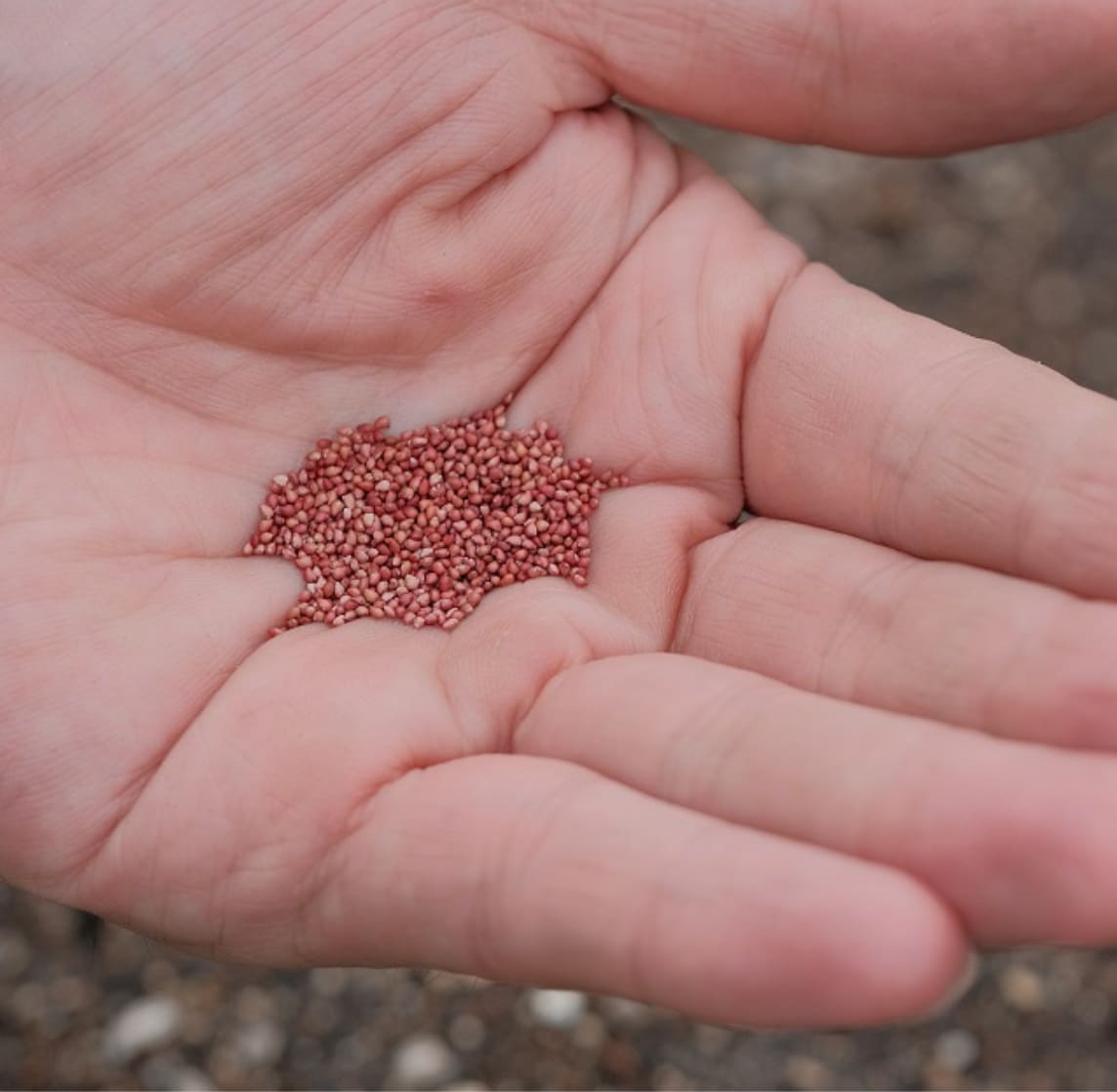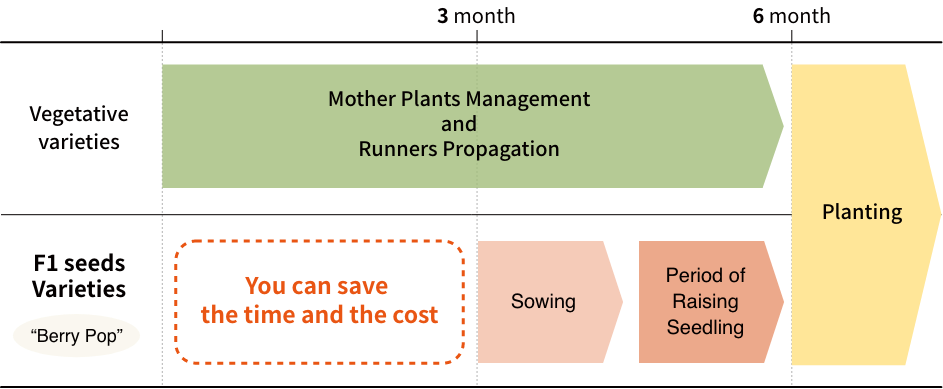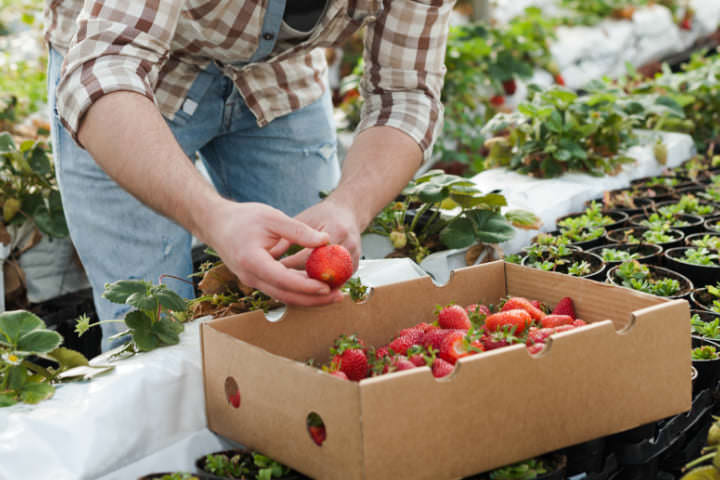ABOUT
MIYOSHI F1 SEED STRAWBERRIES
Japanese distinctive “Sweet Strawberry”
developed by Japanese eating habit and
highly competitive market.
In Japan, strawberries are mainly eaten in raw. Therefore, freshness and the quality of the varieties have continuously been improved based on the breeding competition and quality control among the local production areas for long time. At least there are more than 300 varieties that are officially registered in the varieties database of Japanese Ministry of Agriculture, Forestry and Fisheries and even more new varieties are being developed every year.
Japanese breeding technology and growing system of strawberry are known to be one of the most developed ones in the world.
MIYOSHI F1 SEED STRAWBERRIES “Berry Pop” as the original F1 seed strawberry is born in this very highly competitive Japanese strawberry market.
Why don’t you try the great collaboration of moderate sourness and distinctive sweetness of Japanese strawberries through our varieties?
You can experience at your own region or country the reason why many foreign tourists who visit Japan are impressed with their sweetness and juiciness.

MIYOSHI F1 SEED STRAWBERRIES “Berry Pop”
will bring the laborsaving innovations
and improve production efficiency in your farms.
MIYOSHI F1 SEED STRWBERRIES “Berry Pop” do not require your time-taking mother plants management and stock storage anymore since they are propagated from seeds. They could make the period of raising seedling shorter from about 6 months to 3 months in Japan.
If you have longer period of raising seedling that includes cold treatment, you could save more time.
Furthermore, this term shortening will bring less pest and disease risk as well.
Thus, these strawberries will lead to production cost reduction, energy saving and because of their short period of raising seedling, the fruits will be produced with less agricultural chemicals.
- Unnecessary mother plants management
- Unnecessary runner propagation
- Shortening of period of raising seedling
- Reduction of agrochemicals used during the period of raising seedling
- Less risk of pests and diseases
MIYOSHI F1 SEED STRAWBERRIES “Berry Pop”
are environment-friendly.
The Japanese research center calculated the LCA (Life cycle assessment) of MIYOSHI F1 SEED STRAWBERRIES “Berry Pop”as an advantage at the point of c arbon dioxide emissions. From the stage of seed production to raising seedlings, it reduces totally 41%* than the ordinal strawberry cultivation method.
Only in the case of using fertilizers or chemicals, it reduces 78%* of carbon dioxide emissions during those stages.
*Based on our research in March 2022
●Life Cycle Assessment / CO2 Emission
Total reduction %
In case of reduce pesticide, fertilizers and other chemicals %
41%
78%
The reduction rate of carbon dioxide emissions is calculated by the LCA module. The data collected during the seed pr oduction stage to raising seedling stage.

How could we save the production cost and time?

For Strawberry Growers

- Since MIYOSHI F1 SEED STRAWBERRIES varieties “Berry Pop” will be delivered in seeds, the growers can grow Japanese varieties even in the regions or countries where they do not permit importing the vegetative strawberry plants from Japan.
- Since our F1 seeds do not need the runner propagation at your farm, the growers can save the production space, time and labor cost.
- Since shortening of period of raising seedling, the growers can reduce the chemical spraying and it will be less stressful for the grower’s health and environment.
For Sales Distributors and Propagators/Young Plant Producers

- As your new commodity, you can add the attractive “Japanese Strawberry” to your product lineup.
- Since you can distribute in seeds, it is possible to have stock at your facilities. The seeds are preservable for years under ideal condition.
- In case you are planning to supply them as young plants, it allows you to make simple production schedule. All you need is fixing the sowing date after counting back from the delivery date.
You may also be able to deal with urgent orders.
For Consumers

- The sweet “Japanese Fresh Strawberries” which importing has been restricted for long time will become one of your options at your nearest supermarket in the future.
- You can taste not only imported Japanese Strawberry but the fresh ones that are provided by the local producers.
- You could enjoy “Japanese Strawberry” that are more healthy and gentle to your body because of the less agricultural chemicals used during the production period.

MIYOSHI F1 SEED STRAWBERRIES
will keep improving strawberry varieties.
The varieties “Berry Pop HARUHI” and “Berry Pop SAKURA” that we introduce as the first generation both belong to Short Day type.
MIYOSHI is planning to expand our varieties lineup onto Day Neutral and Open Field types as well in the future.
Short Day type
Generally, the fruits are harvested from Winter to Spring. In Japan harvest season starts in December and ends in May. “Berry Pop HARUHI” and “Berry Pop SAKURA” belong to this type.
Day Neutral type
Basically, this type strawberry tends to be a bit sourer and the fruits would be harder than Short Day type.
The fruits are harvested from Summer to Autumn. Under Japanese climate, the harvest season starts in June and ends in November.
Open Field type
The high disease resistance and strong hard fruits tend to be selected for this type.

